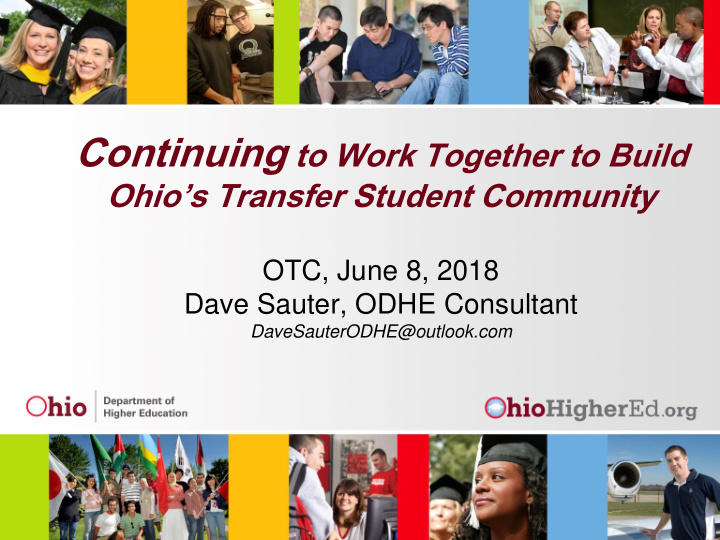



Continuing to Work Together to Build Ohio’s Transfer Student Community OTC, June 8, 2018 Dave Sauter, ODHE Consultant DaveSauterODHE@outlook.com
SGCT – Statewide Guarantee Credit Transfer 2016 Charter • Standardized coding, reporting, and possible transcription of the SGCTs • An Ohio initiative to impact secondary and postsecondary Ohio institutions, public and private, as students “circulate to success"
Today's Agenda • OATN Advisory Council November 2017 • Status check since OTC 2017 Conference • Chris' Story • Review the approved coding – HEI site as source • Transcription Exploration Project • Look to the future including Timelines: October 2018 institutional database; January 2019 HEI reporting
November 16, 2017 OATN Advisory Council Minutes' Excerpts • Institutions should create partnerships • There is power in partnerships between secondary and post-secondary institutions • Understand the impact of transfer initiatives • Understand quantitative transfer activity data • Provide the best resources and knowledge • Provide seamless transfer for student success; 2-year institutions tied to 4-year institutions equals higher transfer student graduation rates
Today’s Status – What We Now Know • Current status of the ODHE SGCT project – institutional success at identifying the 23 SGCTs, definitions established and coding underway • Pilot schools (and “piloteers”) developing SIS - specific best practices and roadmaps e.g., Banner, PeopleSoft (6 SISs for 36 institutions) • Increased understanding of the various SGCTs – tests such as AP, transfer courses such as MTAG and CTAG, and home/native “courses” such as CBE (Competency Based Education)
Status…continued • Institutional teams operationalizing the SGCTs – IT, IR, Reg, Adm, Provost, etc. • HEI Alternative File (AC) January 2019 and January 2020 data – the data differences • Reminder of value for the student, and reviewers, in standardization across institutions…degree attainment! • Need to show constituent success/value…including future funding potential • Dave & Sun Jamerson consulting partners
Chris’ Story – SGCT Matters • Chris begins a college journey by accumulating college credits in various ways while still at the secondary level: 1. Classes at a university under the College Credit Plus initiative, CCP 2. Classes at a high school under the Advanced Placement initiative, AP 3. Classes at an area career technical center under the Career Technical Assurance Guide initiative, CTAG
Chris’ Story…continued • Chris graduates from secondary school and attends a local 2-year institution. As Chris begins a two-year college program the college-level academic record has already been established: 16 credits successfully passed, transcripted, and reported to the state via HEI. With 44 more credits earned, Chris’ associate’s degree is awarded – including 6 online credits. Chris’ experiences so far include 4 secondary and post-secondary institutions.
Chris’ Story…continued • Next, Chris transfers to a 4-year institution to pursue a baccalaureate degree. Chris continues accumulating credit via online coursework from another institution, and as a military serviceperson can receive MTAG credit. 60 credits later the baccalaureate degree is awarded, now reflecting credits from six secondary and post-secondary experiences.
Chris’ Story…continued • Since 12 of the 120 credit hours taken for the baccalaureate degree count toward a graduate degree, Chris completes a graduate-level certificate and ultimately the master’s degree... now 7 institutions' credits. As Chris looks back: credits via the home institution and credits from elsewhere, seamlessly transferred, evaluated, articulated and reported - standard and timely processes… success for Chris.
Beyond Coding…Transcription Exploration Project • 25 institutions participating via questionnaire in exploring the feasibility, interest, and need of standardizing credit transfer codes on electronic transcripts exchanged via the Articulation and Transfer Clearinghouse (ATC) • 8 categorical issues evolved in this phase, from prior SGCT work and two webinars this spring; the liaison for each of the 25 participating schools will provide their feedback by June 20 • The 11 remaining schools were sent the questionnaire and invited to respond
8 Transcription Issues • TOPIC ONE: adding details to the 23 SGCT codes on the transcript – e.g., AP date and score • TOPIC TWO: trusting the original source for SGCT data as transcribed by other institutions – vs. “back to the source(s)” • TOPIC THREE: XML data imported automatically into institutional SIS – several do so now • TOPIC FOUR: Potential for a State of Ohio Academic Record Repository (SOARR) – SGCTs and Grade Legends
8 Transcription Issues…continued • TOPIC FIVE: institutional SIS academic record as well as varying outputs – what differences, if any, on the degree audit and transcripts (and other paper/e-documents • TOPIC SIX: institutional (native) credit and non-institutional (non-native) credit – institutional differences?; licensure, accreditation, certification considerations?
8 Transcription Issues…continued • TOPIC SEVEN: Disaggregated SGCTs versus Aggregated credit – Pathways, block credit…need to know specific credits? • TOPIC EIGHT: expanding SGCT initiative beyond the 36 Ohio public state institutions – AICUO conversation June 21
The Future • June 13 status check on the progress of institutions in coding their database for HEI reporting January 2019 • June 13 status check on the questionnaire, for Transcription Exploratory Project report July 1 • Explore research potential for transfer issues once data on the 23 SGCTs is reported – MTAGs already in progress • HEI baseline SGCT data September 2018 vs. future of January 2019 and January 2020
Q & A THANK YOU! Dave Sauter – DaveSauterODHE@outlook.com
Recommend
More recommend